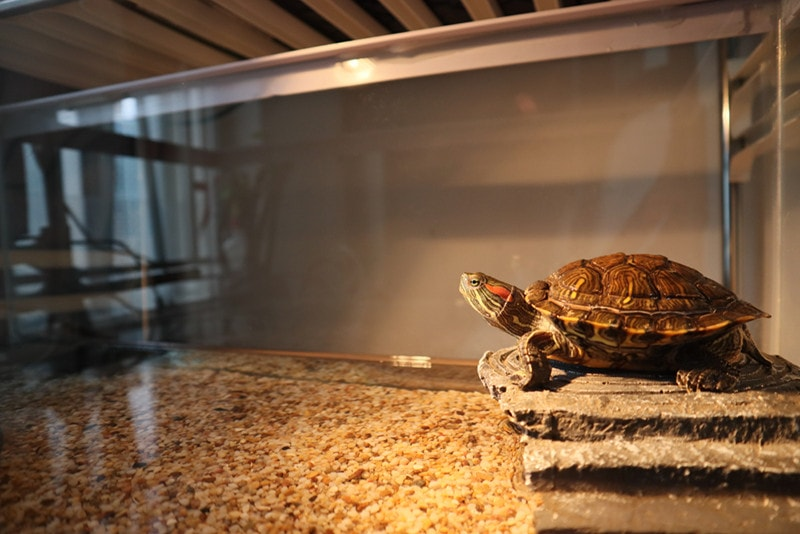How to Create the Perfect Home for Your Box Turtle

Ever thought about creating a cozy and enjoyable home for your pet box turtle? We’ve created a guide to share tips on how to make a habitat that’s comfortable, safe, and fun for these interesting creatures.
Our guide will walk you through the process, providing all the information you need to care for your box turtle with care and know-how. Let’s work together to create the ideal home for them!
About Box Turtles
The box turtle, also known as the Terrapene carolina, is a popular pet choice for reptile enthusiasts. These small land-dwelling turtles are native to North America and can be found in various habitats such as forests, grasslands, and even suburban areas. Box turtles are known for their unique appearance with a high-domed shell and hinged plastron (bottom shell) that allows them to fully close themselves inside for protection.
Box turtles make great pets because of their docile nature and low maintenance needs. However, it’s important to note that they require specific care and a suitable habitat in order for them to live a happy and healthy life.
The Importance of a Proper Habitat for Box Turtle
The habitat of a box turtle is crucial for their overall health and well-being. A proper habitat provides them with a safe, comfortable, and stimulating environment to thrive in. In this section, we will discuss the importance of creating a suitable habitat for your box turtle.
1. Mimics their natural environment:
One of the primary reasons why a proper habitat is essential for box turtles is that it mimics their natural environment. In the wild, box turtles live in grasslands, woodlands, and meadows with access to both land and water sources. By recreating this environment in captivity, you are providing them with a familiar and stress-free setting.
2. Maintain ideal temperature and humidity levels:
Box turtles are ectothermic animals, which means they rely on external sources to regulate their body temperature. Therefore, it is crucial to maintain ideal temperature levels in their habitat to ensure proper digestion, metabolism, and overall health. The recommended temperature range for box turtles is between 75-85 degrees Fahrenheit during the day and can drop slightly at night. Additionally, maintaining proper humidity levels of 50-60% is vital for healthy skin and shell growth.
3. Encourages natural behaviors:
A proper habitat also allows your box turtle to exhibit natural behaviors such as burrowing, basking under UVB light, and exploring different areas within their enclosure. These activities help keep them mentally stimulated and physically active.

Choosing the Right Enclosure for Box Turtle
Choosing the right enclosure is crucial for creating a perfect habitat for your box turtle. A suitable enclosure will not only provide a safe and comfortable living space, but it will also promote natural behaviors and allow for proper growth and development of your pet.
1- Size:
The first thing to consider when choosing an enclosure is the size. Box turtles require ample space to move around, explore, and exercise. As a general rule of thumb, the enclosure should be at least 3-4 times the length of your turtle’s shell and twice as wide. This will ensure that your turtle has enough room to roam and simulate their natural environment.
2- Type of Enclosure:
There are several types of enclosures available in the market, including glass tanks, plastic tubs, wooden cages, and outdoor pens. Each type has its advantages and disadvantages, so it’s essential to consider your specific needs before making a decision.
Glass tanks are popular choices because they allow you to observe your turtle easily. However, they can be challenging to maintain proper humidity levels. Plastic tubs are lightweight, easy to clean, and offer good ventilation. Wooden cages are aesthetically pleasing but may require more maintenance due to potential wood rot from high humidity levels. Outdoor pens provide plenty of space for your turtle but require regular monitoring for predators such as cats or raccoons.
3- Substrate:
Another important factor in choosing an enclosure is the substrate or bedding material used on the floor. The ideal substrate should retain moisture well while allowing excess water to drain
4- Diet and Nutrition for Box Turtles
Diet and nutrition play a crucial role in the overall health and well-being of your box turtle. Providing a balanced and varied diet is essential for ensuring proper growth, energy levels, and disease prevention.
A box turtle’s diet should mimic their natural food sources found in the wild. This includes a mix of plant-based foods such as fruits, vegetables, and leafy greens, as well as protein-rich foods like insects and small amounts of animal protein. The ratio of plant-based to animal-based foods can vary depending on the age and species of your box turtle.
Leafy greens such as collard greens, mustard greens, dandelion greens, and turnip greens should make up about 50% of your turtle’s diet. These provide essential vitamins and minerals such as calcium for strong bones and vitamin A for healthy eyesight.
In addition to leafy greens, you can also offer a variety of other vegetables such as carrots, squash, bell peppers, zucchini, broccoli, and green beans. Fruits like strawberries, blueberries, melons, apples (without seeds), and figs can be given occasionally as treats but should not make up more than 10% of their overall diet due to their high sugar content.
Protein is an important part of a box turtle’s diet. Insects like crickets, mealworms (in moderation), earthworms (a favorite among turtles), snails (can be found in most gardens), caterpillars (avoid those that are hairy or poisonous), and even small rodents such as mice and rats can provide the necessary protein for a healthy turtle.
Cleaning and Maintenance of Box Turtle Habitat
One of the most important aspects of creating a perfect habitat for your box turtle is ensuring that it is clean and well-maintained. A dirty or unsanitary environment can lead to various health issues for your pet, so regular cleaning and maintenance should be a top priority.
Here are some essential tips on how to properly clean and maintain your box turtle’s habitat:
1- Daily Spot Cleaning:
The first step in maintaining a clean habitat is to do daily spot cleaning. This involves removing any visible waste or uneaten food from the enclosure. You can use a small scoop or paper towel to remove the waste and replace any soiled substrate with fresh bedding.
2- Weekly Deep Clean:
Aside from daily spot cleaning, it is also crucial to deep clean the entire habitat at least once a week. This includes removing all decorations, substrate, and other accessories from the enclosure and thoroughly washing them with warm water.
3- Disinfecting:
After removing all items from the enclosure, it is essential to disinfect them before putting them back in. Use a reptile-safe disinfectant or a mixture of water and white vinegar (1:1 ratio) to clean all surfaces thoroughly.
4- Cleaning Substrate:
The substrate in your box turtle’s habitat should be replaced every 2-3 months, depending on how quickly it gets soiled. If you notice an unpleasant odor coming from the enclosure, it may be time for a substrate change.
Common Health Issues and How to Prevent Them
Box turtles are fascinating creatures that make great pets. However, like any living being, they are susceptible to certain health issues that can be prevented with proper care and maintenance. In this section, we will discuss some of the common health issues that box turtles may face and how you can prevent them.
1- Box Turtle Respiratory Infections:
Respiratory infections are a common health issue in box turtles. They can be caused by poor air quality, inadequate temperature and humidity levels, or exposure to drafts. Symptoms include difficulty breathing, wheezing, a runny nose, and lethargy.
To prevent respiratory infections, it is important to maintain a clean and well-ventilated habitat. Regularly clean the enclosure and remove any uneaten food or feces. Additionally, make sure to provide proper heating and humidity levels according to your specific species’ needs.
2- Box Turtle Shell Rot:
Shell rot is another common health issue in box turtles that can lead to serious complications if left untreated. It is caused by bacteria or fungi entering through cracks or injuries on the shell and causing infection. Signs of shell rot include discoloration or softening of the shell, foul odor coming from the shell area, and decreased appetite. To prevent shell rot, provide a clean environment free from debris and check for cuts or scratches on the shell.
Once you know what your box turtle needs in its home, it’s crucial to also know how to take good care of it. Looking after a box turtle means being committed and dedicated because they have specific needs that need attention for them to be happy and healthy.
Also read: Beyond Cats and Dogs: Diving into the World of Exotic Pets
Want to save money on your pet expenses and get exclusive offers? Check out : Pet Perks Membership
If you loved this article, you will also love reading our eBook Dubai Ruff Guide
For more furry destinations, the latest blogs, events, and providers you can stay updated by following us on Instagram and signing up for our newsletters.

